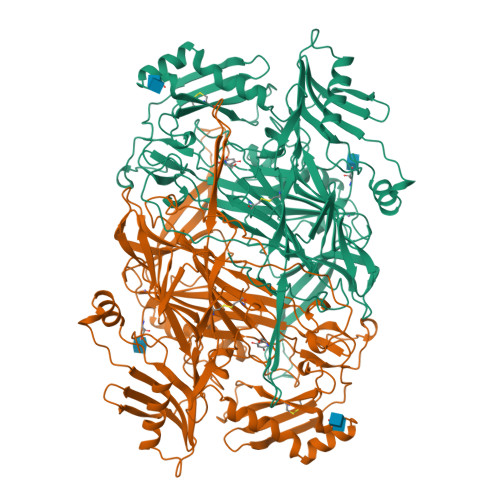Crystal structure of a eukaryotic (pea seedling) copper-containing amine oxidase at 2.2 A resolution.
Kumar, V., Dooley, D.M., Freeman, H.C., Guss, J.M., Harvey, I., McGuirl, M.A., Wilce, M.C., Zubak, V.M.(1996) Structure 4: 943-955
- PubMed: 8805580
- DOI: https://doi.org/10.1016/s0969-2126(96)00101-3
- Primary Citation of Related Structures:
1KSI - PubMed Abstract:
Copper-containing amine oxidases catalyze the oxidative deamination of primary amines to aldehydes, in a reaction that requires free radicals. These enzymes are important in many biological processes, including cell differentiation and growth, would healing, detoxification and signalling. The catalytic reaction requires a redox cofactor, topa quinone (TPQ), which is derived by post-translational modification of an invariant tyrosine residue. Both the biogenesis of the TPQ cofactor and the reaction catalyzed by the enzyme require the presence of a copper atom at the active site. The crystal structure of a prokaryotic copper amine oxidase from E. coli (ECAO) has recently been reported. The first structure of a eukaryotic (pea seedling) amine oxidase (PSAO) has been solved and refined at 2.2 A resolution. The crystallographic phases were derived from a single phosphotungstic acid derivative. The positions of the tungsten atoms in the W12 clusters were obtained by molecular replacement using E. coli amine oxidase as a search model. The methodology avoided bias from the search model, and provides an essentially independent view of a eukaryotic amine oxidase. The PSAO molecule is a homodimer; each subunit has three domains. The active site of each subunit lies near an edge of the beta-sandwich of the largest domain, but is not accessible from the solvent. The essential active-site copper atom is coordinated by three histidine side chains and two water molecules in an approximately square-pyramidal arrangement. All the atoms of the TPQ cofactor are unambiguously defined, the shortest distance to the copper atom being approximately 6 A. There is considerable structural homology between PSAO and ECAO. A combination of evidence from both structures indicates that the TPQ side chain is sufficiently flexible to permit the aromatic grouf to rotate about the Cbeta-Cgamma bond, and to move between bonding and non-bonding positions with respect to the Cu atom. Conformational flexibility is also required at the surface of the molecule to allow the substrates access to the active site, which is inaccessible to solvent, as expected for an enzyme that uses radical chemistry.
Organizational Affiliation:
School of Chemistry, University of Sydney, NSW 2006, Australia.























